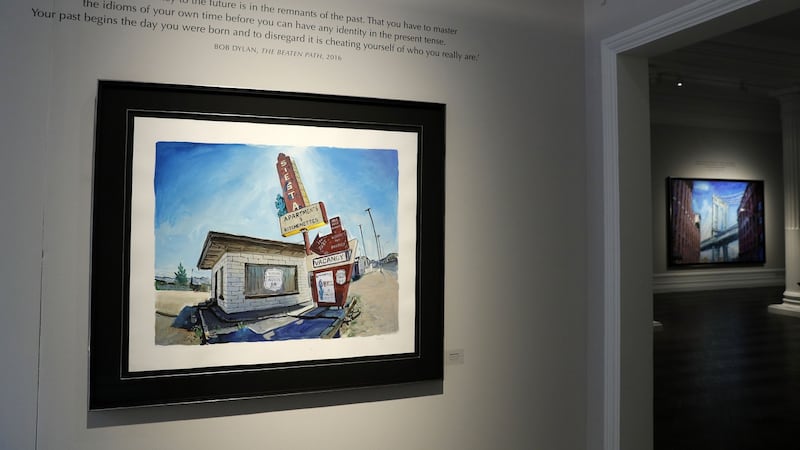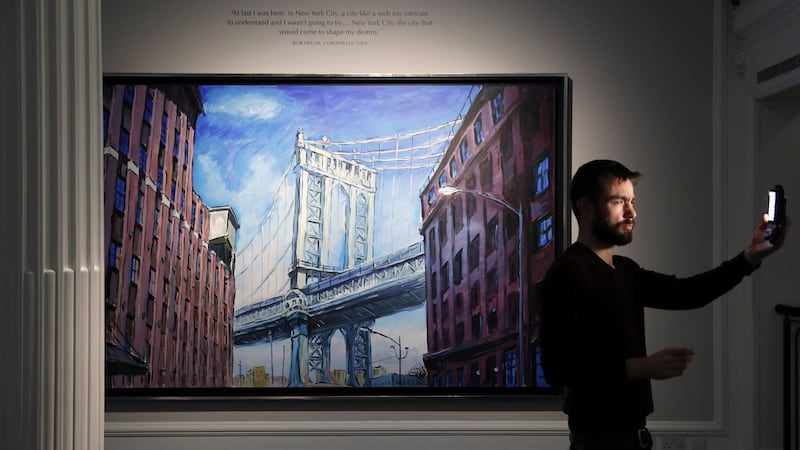Bob Dylan cited "pre-existing commitments" when he announced that he will not be in Stockholm next month to collect his Nobel Prize for Literature.
Grievance hounds pounced on the fact that he has no scheduled concerts after this week to suggest that Dylan was insulting the academy, which had gone out on a limb by honouring the singer-songwriter.
There is no doubt, however, that Dylan is a busy man, performing about 100 times a year across the United States, usually in small venues in out of the way places.


The Beaten Path
Now The Beaten Path, an exhibition in London's Halcyon Gallery (until December 11th) reveals him to be a prolific visual artist too.
Occupying three floors of a building on Mayfair’s deeply un-Dylanesque New Bond Street, with Ralph Lauren next door and Jimmy Choo across the road, the show numbers more than 250 of his drawings, watercolours, acrylics and ironworks.
Dylan started drawing in the 1960s, and one of his drawings was on the cover of The Band's 1968 debut album Music from Big Pink.
He published a book of drawings in the mid-1990s but started painting in acrylics only a few years ago.
Dylan produced many of the works in The Beaten Path while on the road in the "Never Ending Tour", which has been going on for the past two decades.
At the centre of the exhibition is a monumental painting of an “Endless Highway” stretching out into the horizon ahead.
“The common theme of these works having something to do with the American landscape – how you see it while crisscrossing the land and seeing it for what it’s worth. Staying out of the mainstream and travelling the back roads, free-born style,” Dylan writes in a foreword to the catalogue.
“I believe that the key to the future is in the remnants of the past. That you have to master the idioms of your own time before you can have any identity in the present tense.
“Your past begins the day you were born and to disregard it is cheating yourself of who you really are.”
Dylan was born in Minnesota, growing up in the iron mining town of Hibbing, and the pictures in the exhibition are interspersed with his welded iron sculptures.
Dylan portrays a small-town America apparently suspended in the middle of the 20th century, when he was young, a world of diners, movie theatres, hot dog stands and classic cars.
Even when he paints a contemporary scene, such as a couple on a pier in Virginia in 2015, the figures are dressed as if they could have been from the 1950s.
‘Keep things simple’
“My idea was to keep things simple, only deal with what is externally visible.
“These paintings are up to the moment realism – archaic, most static, but quivering in appearance. They contradict the modern world. However, that’s my doing,” he writes.
“The San Francisco Chinatown street stands merely two blocks away from corporate, windowless buildings. But these cold giant structures have no meaning for me in the world that I see or choose to see or be a part of or gain entrance to.
“If you look half a block away from the Coney Island hot-dog stand, the sky is littered with high rises. I choose not to see them either.”
Although many of his early songs are anthems of the political left, Dylan has said little about politics in recent years, apart from welcoming Barack Obama’s election as president in 2008.
If The Beaten Path suggests a conservative outlook, it is a conservatism which is less political than aesthetic.
Dylan’s pictures celebrate forgotten corners of America, deliberately excluding the features of contemporary life he dislikes, which includes the media in which most Americans are immersed.
“There was a conscious attempt to dismiss consumer culture or popular culture, including mass media, commercial art, celebrities, consumer or product packaging, billboard signs, comic strips, magazine advertising.
‘The Beaten Path’ works represent a different subject matter from the everyday imagery of consumer culture,” he writes.
Dylan discourages a psychoanalytical reading of his art, insisting that none of the paintings are based on images that occur in dreams, fantasy worlds or religious mysticism.
“In every picture the viewer doesn’t have to wonder whether it’s an actual object or a delusional one,” he writes.
“If the viewer visited where the picture actually existed, he or she would see the same thing. It is what unites us all.”











